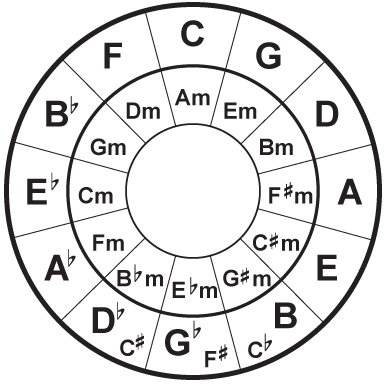All scales come from 1 main scale, which is the major scale. In scales, there are a certain number of sharps and flats. You can use the circle of fifths to: read how many sharps and flats there are in a scale, to help you better make and play scales, understand scales better, and build more scales. This is a very important topic, so if you don’t about it yet, READ THIS! It will really help you with learning new songs, writing songs, and improvising/soloing. Gb = G Flat, incase you didn’t know (which you should)
This is the Circle of Fifths. It is used to build all sorts of scales. It may look confusing at first, but it is actually very simple to use. So let’s first take a look at the C Major Scale:
C D E F G A B C
As you can see it has no sharps or flats, so you call the C Major Scale Natural (natural means it has no sharps or flats). Now let’s take a look at the G Major Scale:
G A B C D E F# G
G major does have 1 Sharp. You may not have known this, and may be wondering how to figure it out. That’s were the circle of fifths comes in. All the notes Clockwise to C are Sharp. All the notes counter-clockwise to C are flat. So when we look at G, it is 1 away from C when looking at it clockwise, so it has one sharp note. D is 2 away from C, so D Major has two sharp notes. A Major has 3 sharp notes, and so on. Starting to make sense now?
Now let’s take a look at the other side. Finding out the Flats on that side are the same as finding how many sharps are in a scale on the other side, except you’re going to count counter-clockwise. For Example, to find how many Flats are in F Major, since F is 1 away from C, going counter Clockwise, F major has one Flat note. B flat Major has 2 flat notes, and so on.
So now that you know how to figure out how many sharp and flat notes are in a scale, it’s time to learn what those notes are. To do this, we use a simple “Formula”: FCGDAEB. You can make up some kind of words to memorize it, such as Father Christmas Gave Dad An Electric Blanket. Whatever you do to remember it, just remember. So what you do with it though, is count how far a root note of a scale is from C again, for example, D is 2 away from C. Then you count that many of the letters from our formula thing earlier, which was FCGDAEB. So the first 2 letters of that are F and C. That means that F and C are the only sharp notes in that major scale. Another example would be E Major. It is 4 away from C, so it has 4 Sharp notes. Those sharp notes are the first 4 notes of the group of letters, FCGDaeb. So F, C, G, and D are the sharp notes in E Major. All you have to do is take the number of however many notes are sharp in a scale, and count that many of that number in the group of letters.
Finding out the flat notes of the other scales on the other side are the same thing, but in reverse. Since we count the letters in reverse when finding out how many flat notes are in the scale, we use the “formula” backwards, making it BEADGCF. Let me give you an example: B flat is 2 away from C when counting counter-clockwise, so you use the first 2 letters of the backwards formula, showing you that B and E are the flat notes in the B Flat Major Scale.
Also note that F# is also Gb, B is also Cb, and Db is also C#, as you can see above.
written by gods guitarist
http://www.ultimate-guitar.com/lessons/scales/the_circle_of_fifths_explained.html


No comments:
Post a Comment